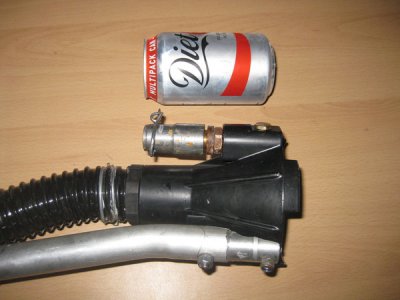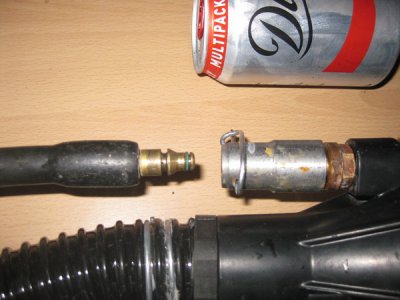- Joined
- Jul 9, 2014
- Messages
- 613
I am intending to make an adaptor for my power washers pond cleaning suction hood attachment . The base metal is die cast aluminium or similar.
The place where I have to attach the power washer hose is tapped to 19 tpi for a 1/2 " gas thread.
Looking carefully at the brass quick disconnect end spigot of the washers hose shows me that any brass part I turn up to make the connector will have about 1.5 mm of wall if I purchase a ready made union component & will be liable to snap off or rupture at this thin area the moment that it gets the full 150 bar of the power washer pushing on it .
Because the feed is 19 TPI my old Sphere lathe does not have the capability of auto carriage feed being related to the thread indicator on the correct place to start the threading passes.
I can do it all manually , it's a lot of messing about , but due to the cost of the PBA I'd rather not take the chance of messing up this little bit of work .
I can adapt a ready made & threaded union fairly easily by boring it through and having a 1 mm wall plus the gas thread sleeve which I can then turn up an insert of PBA for that will also include the spigot capture device.
So I have coughed up , released the moths from my wallet and purchased 150 mm of 30 mm dia phosphor bronze round bar to make a strengthener with a more common thread on one end to go inside the bored out factory made union and then add my home made adaptor with the same but internal thread on & sweat solder them into a single unit.
150 mm of 30 mm dia phosphor bronze round bar to make a strengthener with a more common thread on one end to go inside the bored out factory made union and then add my home made adaptor with the same but internal thread on & sweat solder them into a single unit.
I've never ever worked phosphor bronze before ..had a play several times with various types of brass and found it was OK so long as I kept speeds & feeds down & if I remember correctly ground 3 to 4 degree cutting angles with 7 to 9 degree clearance angles on the drills used for drilling small tapping holes or boring larger holes .
In this Phosphor Bronze alloy ( PBA) I hope to drill two 4 mm holes for tapping and chain drill nine 2.5 mm holes to make a slot for the locking on device . In the main body that will capture the spigot end of the pressure hose I'll be running a 5 mm hole right through a piece of PBA that is 40 mm long, with a bigger hole at 11.2 mm dia and 24 mm deep .
Has anyone got any useful tips they'd be willing to pass on to me .
Dave
The place where I have to attach the power washer hose is tapped to 19 tpi for a 1/2 " gas thread.
Looking carefully at the brass quick disconnect end spigot of the washers hose shows me that any brass part I turn up to make the connector will have about 1.5 mm of wall if I purchase a ready made union component & will be liable to snap off or rupture at this thin area the moment that it gets the full 150 bar of the power washer pushing on it .
Because the feed is 19 TPI my old Sphere lathe does not have the capability of auto carriage feed being related to the thread indicator on the correct place to start the threading passes.
I can do it all manually , it's a lot of messing about , but due to the cost of the PBA I'd rather not take the chance of messing up this little bit of work .
I can adapt a ready made & threaded union fairly easily by boring it through and having a 1 mm wall plus the gas thread sleeve which I can then turn up an insert of PBA for that will also include the spigot capture device.
So I have coughed up , released the moths from my wallet and purchased
 150 mm of 30 mm dia phosphor bronze round bar to make a strengthener with a more common thread on one end to go inside the bored out factory made union and then add my home made adaptor with the same but internal thread on & sweat solder them into a single unit.
150 mm of 30 mm dia phosphor bronze round bar to make a strengthener with a more common thread on one end to go inside the bored out factory made union and then add my home made adaptor with the same but internal thread on & sweat solder them into a single unit.I've never ever worked phosphor bronze before ..had a play several times with various types of brass and found it was OK so long as I kept speeds & feeds down & if I remember correctly ground 3 to 4 degree cutting angles with 7 to 9 degree clearance angles on the drills used for drilling small tapping holes or boring larger holes .
In this Phosphor Bronze alloy ( PBA) I hope to drill two 4 mm holes for tapping and chain drill nine 2.5 mm holes to make a slot for the locking on device . In the main body that will capture the spigot end of the pressure hose I'll be running a 5 mm hole right through a piece of PBA that is 40 mm long, with a bigger hole at 11.2 mm dia and 24 mm deep .
Has anyone got any useful tips they'd be willing to pass on to me .
Dave
Last edited:



